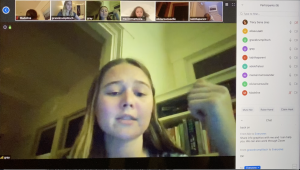High school zooms into college
May 20, 2020
As I say my final goodbyes to teachers and classmates over Zoom, I cannot help but worry that my first semester of college might realistically include meeting professors and attending lectures over online learning platforms instead of in a classroom in Providence, Rhode Island.
The thought that college, which typically includes new opportunities such as living away from home and interacting with students from around the world, could begin online due to COVID-19, is perhaps more disappointing and heartbreaking than the many significant milestones we have already missed as seniors, including celebrating high school graduations, 18th birthdays and prom.
Universities are more than spaces for students to engage in rigorous academic investigation, enlightening debates and research with real-world applications. These institutions foster innovation, educate the next generation of scholars and support the economy.
“Investing in education expands job opportunities, boosts America’s competitiveness, and supports the kind of income mobility that is fundamental to a growing economy,” reported the U.S. Departments of Treasury and Education.
While we can attend online lectures and solve textbook problems, it is impossible to recreate the hands-on interactive learning that in-person teaching provides.
Zoom classes simply cannot replicate environments for meaningful discussions that require eye contact and human connection or the same excitement of scientific investigation students experience while working in a lab.
College is a space where students from all walks of life come together and have the same educational opportunities. This is no longer the case, however, when 21.3 million Americans do not have access to high speed internet meeting the Federal Communications Commission’s benchmark, according to FCC’s latest data from 2017. Without proper internet connection, all students cannot attend online classes and are increasingly disadvantaged compared to their peers who are able to log into class from home.
While I am extremely grateful for my teachers who have worked hard to move our curriculum online and motivate students to learn even through a new platform, Zoom cannot replace in-person classes. More than anything, I hope that students and educators can step foot onto a campus and inside a physical classroom in the fall.












